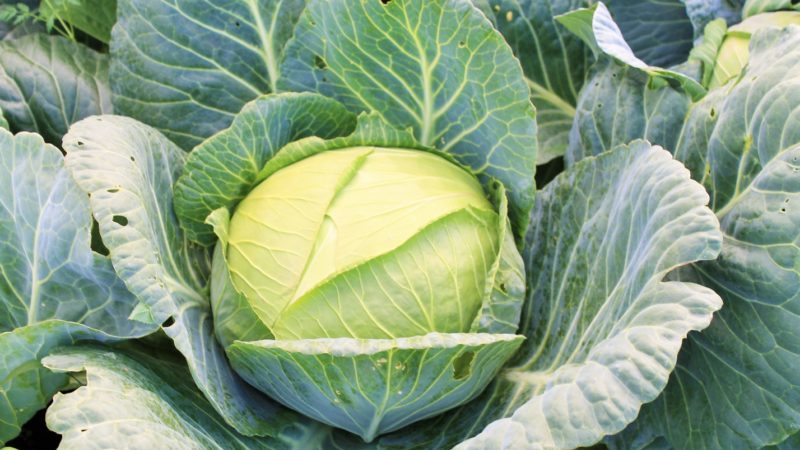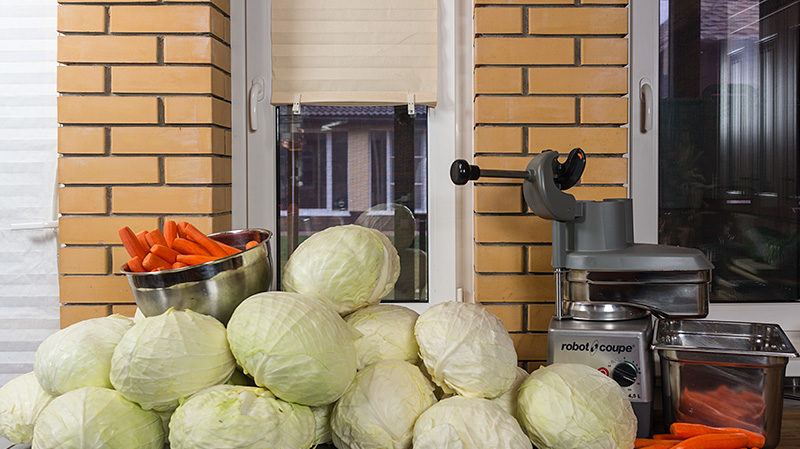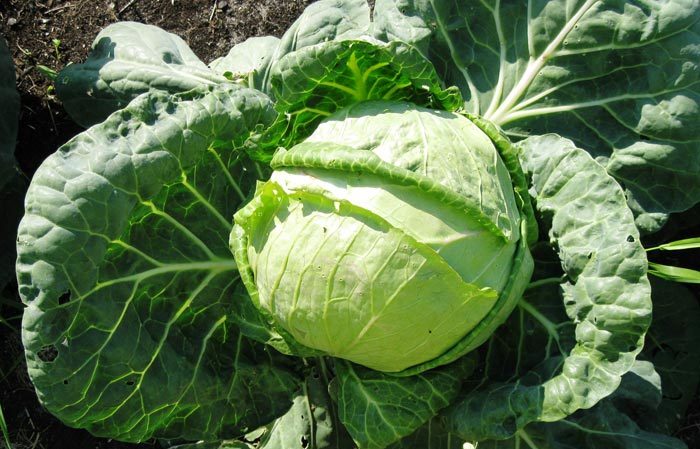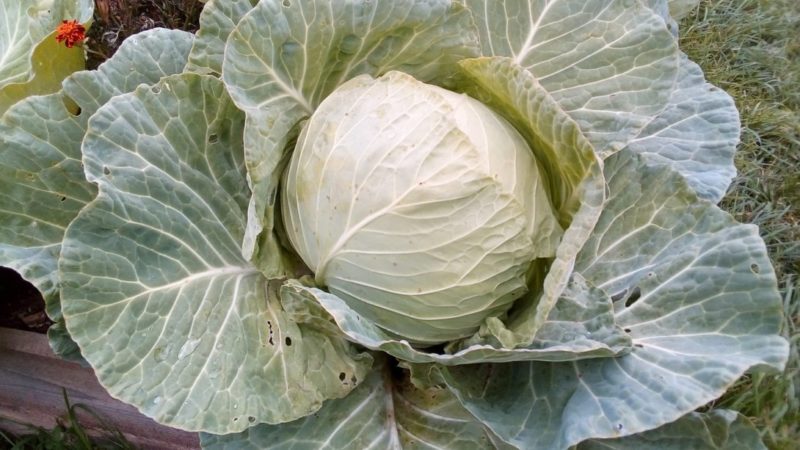Unpretentious cold-resistant cabbage variety "Slava"
White cabbage is one of the most demanded and widespread crops in agriculture. Slava cabbage is very popular. It is distinguished by high yield, juiciness and density of heads of cabbage and has many other advantages.
The content of the article
Description of the cabbage variety Slava

Slava cabbage was introduced to the Federal Research Center for Vegetable Growing. Since 1940, the vegetable has become widespread in all regions of the country.
E.M. Popov became the author of the breeding work. The scientist crossed foreign samples and as a result obtained two varieties of Slava - Gribovskaya 231 and 1305.
The Slava varieties differ only in some indicators. Both are unpretentious and drought tolerant.
Glory 1305
Distinctive characteristics:
- the crop ripens a few days later than Gribovskaya;
- heads of cabbage can weigh up to 9 kg;
- yield indicators are higher than that of Gribovskaya;
- forks are lighter and have a shorter shelf life.
Slava Gribovskaya 231
Vegetables ripen faster, but their weight is 3 times less than the heads of Slava 1305. Yield indicators are lower.
Chemical composition, trace elements and vitamins, useful properties
Slava cabbage contains:
- antioxidants (vitamin C) - 44 mg per 100 g of raw materials;
- sugar - 5.6%;
- dry matter - 11.1%.
The vegetable contains vitamins B, PP and K, tartronic acid, which inhibits the absorption of sugar, so cabbage is allowed for use in diabetes. Methylmethionine promotes recovery in the treatment of ulcers, gastritis, colitis and other gastrointestinal diseases.
Slava cabbage contains micro and macro elements necessary for the body: phosphorus, calcium, sulfur, potassium, iron, manganese, aluminum, zinc.
The vegetable effectively removes cholesterol from the body and normalizes the intestinal microflora. Cabbage is used to fight obesity as mono diets or as an addition to the main diet.
Application features

The variety is used fresh and after processing. The vegetable has a high taste, in pickled form preserves the crunch, so housewives often choose Slava cabbage for pickling.
Ripening period
Slava Gribovskaya 231 ripens on 100-110 days from the day of emergence. Slava 1305 - on average in 101-132 days.
Yield
Both varieties have high yields:
- Slava Gribovskaya 231 - 9-10 kg from 1 m²;
- Slava 1305 - 12 kg from 1 m².
Disease resistance
Slava cabbage has an average resistance to diseases and pests, resists mucous bacteriosis. Problems can arise in case of violation of the rules of care or under the influence of unfavorable weather conditions.
Read also:
Cold resistance
Slava cabbage is frost-resistant and not afraid of the first cold weather... Light freezing improves the taste of the vegetable, gives it a sweetish taste. But the effect of low temperatures on the crop while it is in the garden should not be long. The minimum allowable temperature that cabbage can withstand without losing its qualities is -6 ° C.
It is not recommended to pick vegetables for eating out of the snow at a lower temperature. During the thawing process, microorganisms multiply on the leaves, which cause crop rot.
Attention! You cannot leave cut heads of cabbage in the cold - they will not be stored.
Characteristics, description of the appearance of leaves and head of cabbage, taste

The head of cabbage has a rounded, slightly flattened shape. The diameter can reach 25 cm. The average weight is from 2 to 4.5 kg. The upper leaves are wavy along the edge, light green with a waxy coating. The inner leaves are white and crispy.
Cabbage tastes sweet and juicy.
Growing regions and climate requirements
Slava is suitable for all regions and climatic zones of Russia. Cabbage is not demanding on the soil and is resistant to temperature changes. In the southern regions of the country, you can plant a vegetable in a seedless way.
Advantages and disadvantages of Slava varieties
Main advantages:
- tolerate a lack of moisture - they can grow even in arid regions;
- cold-resistant - the first frosts do not harm the heads of cabbage, but improve their taste;
- are used fresh and processed - suitable for fermentation;
- have a high yield - 658-891 kg / ha;
- transportable and attractive in appearance.
Glory also has several disadvantages:
- susceptible to damage by cabbage keel;
- stored fresh for a short time - until about mid-January;
- prone to cracking when irrigation regime is violated.
Difference from other varieties
Comparison of Slava with other mid-season varieties is presented in the table.
| Variety | Productivity, c / ha | Head of cabbage weight, kg | Ripening period, days | Output of marketable products,% |
| Glory 1305 | 570-930 | 2,4-4,5 | 101-132 | 91-97 |
| Slava Gribovskaya 231 | 658-891 | 2,4-4,5 | 100-110 | 91-97 |
| Belarusian 455 | 474-785 | 1,3-4,1 | 105-130 | 87-98 |
| Losinoostrovskaya 8 | 452-795 | 2,7-3,4 | 115-127 | 91-95 |
| Hope | 696-1128 | 2,4-3,4 | 120-130 | 90-100 |
| Sibiryachka 60 | 341-857 | 2,1-4,3 | 125-140 | 89-96 |
Features of planting and growing
Slava cabbage is grown by seedling and seedling methods. In the first case, the seeds are planted initially in small boxes, and in the second - immediately into the open ground.
Training
Before boarding, it is recommended:
- Place the seeds in water at a temperature of + 55 ... + 60 ° C for 15 minutes.
- Then immerse them in cool water for 1 minute.
- Prepare a solution: use 12 g of potassium humate for 10 liters of water.
- Pour the seeds with the resulting product and leave for 12 hours.
- After the specified time has elapsed, dry the planting material and place in a cool place.
After a day, the seeds can be planted.
How to make a seedless plant
With a seedless method:
- Sow seeds into the ground to a depth of 2 cm.
- Thin seedlings after the formation of 3 leaves.
- Repeat the procedure after 6 leaves appear, leaving 60 cm between the shoots.
Ground requirements
Any soil is suitable for growing Slava cabbage. But it is recommended to choose a fertile loamy soil with a close location of groundwater. The recommended indicator for the acidity of the earth is ph = 6.7-7.4.
Attention! The time interval between planting cabbage on the same piece of land should be at least 3-4 years.
Timing, scheme and landing rules
For growing seedlings, seeds are sown in boxes in early April. With the seedless method, seeds are planted in open ground in the third decade of April. In the south, sown after March 25.
The scheme of planting seedlings in the soil is 60 × 60 cm.
In most regions of Russia, the seedling method is used. Planting instructions:
- Prepare boxes 5-6 cm deep.
- Pour soil into containers.
- Compact the soil and treat with a solution of potassium permanganate.
- After three days, make furrows 1 cm deep at a distance of 3 cm from each other.
- Sow seeds.
- Sprinkle the crops with earth and water.
- Place the boxes in a warm place until germination.Temperature range - + 18 ... + 20 ° C.
- After the sprouts appear, transfer the boxes to a lighted windowsill. Maintain the temperature within the range of + 10 ... + 12 ° C. Otherwise, the sprouts will quickly stretch upward, which is dangerous by deformation and death of the plant.
- After the formation of 5 leaves, plant the seedlings in open ground.
Growing features
Often when growing cabbage, mistakes are made that lead to the formation of a shoot. To avoid this, they take into account the peculiarities of the growing season of the culture and do not allow:
- dense planting of seedlings;
- lack of lighting;
- excess moisture.
To obtain a bountiful harvest, the plantings are regularly looked after:
- Watering. Slava cabbage loves moisture, so it is watered about 8 times a month.
- Loosening. It is performed after each watering to ensure oxygen access to the plant's root system.
- Hilling. The procedure helps the formation of root shoots. As a result, the plant will receive more nutrients.
- Top dressing. Nitrogen fertilizers are applied 15 days after planting. In the process of forming heads of cabbage, the plant requires phosphorus and potassium supplements.
Disease and pest control
The most common disease is the black leg. The disease begins to develop in the root system and can occur even at the initial stage of growth, therefore, the seeds are disinfected before planting. In the process of growth, the soil is loosened, previously sprinkled with ash.
If the infection has already occurred, treatment is carried out with the drugs "Fitoflavin", "Bactofit", "Trichodermin".
A neighboring site can become a source of pests. The greatest harm to cabbage is caused by aphids. Cool weather and heavy rains can hold back mass distribution. In order to combat aphids, dill and parsley are planted next to the cabbage. These crops are attractive to aphid-eating ladybirds. For the purpose of treatment, the beds are sprayed with tobacco broth or a solution of vinegar (200 ml of the substance and 40 g of soap per bucket of water). Popular drugs for getting rid of aphids are Fitoverm, Iskra, Aktara.
Cabbage moth often settles in the beds. Signs of damage: damaged and drying leaves, yellow spots, lack of growth, plant decay. In this case, complex treatment with insecticides "Aktellik", "Ambush", "Talkord" is carried out.
To reduce the risk of disease, before planting, the land is treated with lime in the amount of 1 kg per 4 m².
Growing difficulties
Sometimes vegetable growers are faced with a problem: cabbage does not form heads of cabbage. The plant actively stretches upward and grows overgrown with leaves. The reasons may be:
- late sowing;
- dense planting;
- violation of the irrigation regime;
- excess nitrogen fertilizer during the formation of the fork.
With proper care, white cabbage Slava always gives dense heads of cabbage.
Harvesting and storage
Slava cabbage ripens by the end of July. On large farms, the harvest time can be up to 2 weeks.
Attention! It is recommended to stop watering 15 days before the planned harvest to avoid cracking the heads.
How and when to collect
The harvest begins in early August. Heads of cabbage are cut with a sharp knife and placed in a shaded place for 3-4 days to dry.
Storage features and keeping quality of the variety
Cabbage is stored in a ventilated basement. Heads of cabbage are laid out on the shelves with stumps up. If there are no free surfaces for laying the crop, it is dug up by the root and suspended by the stump.
At a temperature of 0 ° C and a humidity of 90%, Slava cabbage is kept fresh for no more than 4 months.
Tips and reviews of experienced gardeners about the variety

To get a high-quality harvest, experienced gardeners advise:
- Moisten the beds before planting cabbage and pay attention to the watering regime in the future. It is recommended to use 15 liters of water per 1 m². Each new watering is done after the soil dries up.
- Avoid crust formation - loosen the soil in a timely manner.
Otherwise, according to experienced vegetable growers, Slava cabbage is unpretentious and easy to care for.
Gardeners speak positively about these time-tested varieties.
Irina, Vologda: "Every year I plant Slava cabbage, my sister advised. I get elastic, even, beautiful heads of cabbage, as in the photo of the Slava cabbage variety on the seed packages. I haven’t come across diseases yet ”.
Vladimir, Barnaul: “We grow and use Slava cabbage mainly for pickling. Store fresh heads of cabbage in small quantities. The cabbage is tasty and juicy. "
Read also:
The best Dutch white cabbage varieties and hybrids
The best varieties of cabbage for pickling and storing for the winter
Conclusion
Farmers and gardeners choose Slava for planting more often than other varieties of cabbage. They note its unpretentiousness, taste, large size of heads. With a minimum of effort, you can grow a good harvest even in difficult climatic conditions.